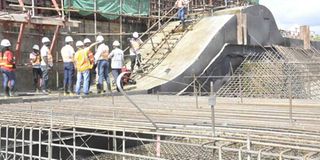World Bank warns government on shoddy infrastructure projects

Engineers at Karuma hydro power dam inspects the cracks at the Spillway last week. The World Bank has singled out the rush to execute projects such as this one, as one of the factors that lead to shoddy work. Photo by Stephen Otage
What you need to know:
Problem. There are low returns from the projects invested in.
Kampala. The World Bank (WB) has told government to improve infrastructure project preparations if Uganda is to realise value for money as well as minimise shoddy works.
The rush to execute projects, coupled with political ambitions to getting things done in a short period of time, is costing the country billions of shillings in shoddy works.
There have been a number of cases, for instance the Mukono – Katosi Road and the two hydroelectricity power projects of Karuma and Isimba, which have become the epitome of shoddy works that critics say have led to wastage of money and time.
Launching Africa’s Pulse report in Washington DC on Monday ahead of World Bank/International Monetary Fund Spring Meetings due this Friday, the World Bank country economist, Dr Jean-Pascal Nguessa, said there is need to improve public investment and management in projects.
“Uganda government needs to improve the quality of infrastructure project preparations by doing right feasibility studies and carrying out proper due diligence in the various infrastructures it is undertaking to realise value for money and also to get good returns in these projects,” he said.
Dr Nguessa said government expenditure on infrastructure projects is high which is good for development of the necessary infrastructure needed to drive economic development though there are relatively low returns from the projects invested in.
Uganda continues to increase public spending through the budget to finance development projects.
However, Dr Nguessa said: “Instead of expanding fiscal space, Uganda needs to do away with deficiencies in public investment and become more efficient in execution of investment in projects.”
Presenting the Africa’s Pulse report in Washington DC in a televised news conference, a World Bank’s twice-yearly analysis of economic trends and latest data for Africa, the acting chief economist, World Bank Africa and the report’s author, Ms Punam Chuhan-Pole, said the 2016 growth forecast in Africa remains subdued at 3.3 per cent 2016, way below the robust 6.8 per cent growth in GDP that the region sustained in the 2003-2008 period. Overall, growth is projected to pick up in 2017-2018 to around 4.5 per cent.
Ms Punam explained that the projected pickup in activity in 2017–18 reflects a gradual improvement in the region’s largest economies including Nigeria, South Africa and Angola.
“Nonetheless, risks to the outlook remain tilted to the downside, including a sharper than expected slowdown in China, further decline in commodity prices, delays in implementing the necessary adjustments to the export price shock in affected countries, worsening drought conditions, and political and security uncertainties,” she said.
For the region as a whole, it is estimated that the impact of the terms-of-trade shock will lower the level of economic activity in 2016 by 0.5 per cent from the baseline, and weaken the current account and fiscal balance by about 4 and 2 percentage points below the baseline, respectively.
Ms Punam said commodity exporters across the region face a new, lower level of commodity prices to which they need to adjust.
Majority of African countries including Uganda are faced with widening fiscal deficit and weak balance of payment.
Slow 2015 activity
The Africa’s Pulse report shows economic activity in Sub-Saharan Africa slowed in 2015, with GDP growth averaging 3.0 per cent, down from 4.5 per cent in 2014 driven by low commodity prices, weak global growth, rising borrowing costs, and adverse domestic developments in many countries. This means that the pace of expansion decelerated to the lows last seen in 2009.




